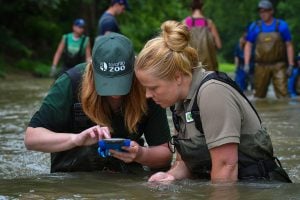What makes an “early bird?”
New tracking technologies provide researchers with opportunities to get out of the lab and study migration timing in the wild, during migration itself. Migrating and breeding early can have lots of advantages for birds, particularly considering the advancing arrival of spring weather that we find in many parts of Canada. But is an early bird born an early bird, or can these habits be learned?
To track the first movements of young birds, we are using a new, automated radio-telemetry array called the Motus Wildlife Tracking System. This is an international collaborative project involving researchers, NGOs such as Bird Studies Canada, and interested citizens who install receiver stations across the landscape. These receivers can detect and log the unique radio signals emitted by tiny tracking tags attached to birds. The system can even be used to track the movements of very small migrants, like dragonflies.
We outfit the birds we study with tiny, radio-tag backpacks that emit a uniquely coded signal every 10 seconds. When birds come within about 20 kilometres of a receiver, their signals are picked up and logged, creating data which can later be used to reconstruct their movements and timing.
These new technologies are very useful for answering questions about migration timing. My PhD student Saeedeh Bani Assadi is looking at how light pollution and other environmental factors impact the individual timing of purple martins as they leave their nests and migrate for the first time. The receiver stations in the Motus network tell Saeedeh exactly when the nestlings start their very first fall migration from breeding sites in Canada on their way to distant overwintering sites in the Amazon region of South America.
Many migratory bird species are declining, and if we wish to conserve ‘our birds’ then it is essential to build strong international relationships to research and protect these species across their full ranges – including, for the purple martin, migration routes through the U.S., Central America, the Caribbean, northern South America, and overwintering areas in Amazonian South America. Our purple martin team includes the Purple Martin Conservation Association based in the U.S., the Instituto Butantan in São Paulo, Brazil, and the National Institute of Amazonian Research in Manaus, Brazil.






